Another survey on subterranean ducts ends in Persepolis, what were the highlights?
The fourth season of an archaeological survey, probing into a sophisticated water management system of the time has come to an end beneath the ruins of the UNESCO-registered Persepolis in southern Iran. Digging into labyrinthine subterranean ducts has yielded significant discoverers some of which noted below:
The survey also sought ways to rescue the fate of the magnificent site from possible damages from surface waters, making sure of its disposal in the same way Achaemenid Persians did some 2,500 years ago.
For many years, during rainy days the tourists and travelers faced several problems due to the flooding and mudslides. On the other hand, this issue tarnished the image of this historical place in public.
While according to historical researches, the Achaemenids had advanced engineering, it seems that the original builders of the place had devised a solution to this issue.
For this reason, several excavations and exploration seasons were carried out to find Persepolis’ ancient water ducts and study how they worked.
Hamid Fadai, the director of the UNESCO-registered site at the beginning of this season of the exploration announced that the ancient water ducts of the site are considered as unique and flawless engineering of its time.
The royal city of Persepolis ranks among the archaeological sites which have no equivalent, considering its unique architecture, urban planning, construction technology, and art.
While this season of exploration was carried out for another purpose, interesting archaeological finds were also made during it.
The remains of 13 ancient skeletons, 11 of which human remains, were discovered at olden water ducts of Persepolis, shedding new light on the way of life in the ceremonial capital of the Achaemenid Empire (c. 550 -330 BC).
The skeletons are now being studied by the archeologists to estimate the historical era they belong to.
The survey also yielded a bas-relief carving, depicting the face of a human being, which was discovered beneath a ruined palace complex in Persepolis. It is widely believed that the piece of art was carved during the Achaemenid epoch.
Archaeologists discovered a prehistorical hatch to the eastern part of Apadana Palace, a majestic ruined royal complex within the site as well.
The hatch was created during the Achaemenid period to repel the surface water of the courtyard, and after this period, it was hidden due to the destruction of the complex.
This vent, like its other counterparts across the Palace, measures 40 cm by 40 cm, connecting the yard surface to underground ducts.
This finding could solve the problem of overflowing at the eastern courtyard of Apadana Palace that is one of the busiest areas of the historical site due to its valuable bas reliefs, and through this, a better situation could be created to protect this section of Persepolis.
Persepolis, also known as Takht-e Jamshid, whose magnificent ruins rest at the foot of Kuh-e Rahmat (Mountain of Mercy), was the ceremonial capital of the Achaemenid Empire. It is situated 60 kilometers northeast of the city of Shiraz in Fars Province.
The city was burnt by Alexander the Great in 330 BC apparently as a revenge to the Persians because it seems the Persian King Xerxes had burnt the Greek City of Athens around 150 years earlier.
The city’s immense terrace was begun about 518 BC by Darius the Great, the Achaemenid Empire’s king. On this terrace, successive kings erected a series of architecturally stunning palatial buildings, among them the massive Apadana palace and the Throne Hall (“Hundred-Column Hall”).
This 13-ha ensemble of majestic approaches, monumental stairways, throne rooms (Apadana), reception rooms, and dependencies is classified among the world’s greatest archaeological sites.
Persepolis was the seat of the government of the Achaemenid Empire, though it was designed primarily to be a showplace and spectacular center for the receptions and festivals of the kings and their empire.
First Time Published in Tehran Times.
